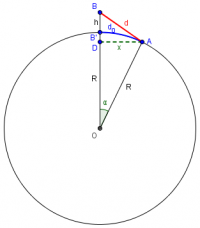I don't think I would be capable of attempting it unless I took a maths course or 4.Yes, I've never attempted the real-earth case at all.
You are using an out of date browser. It may not display this or other websites correctly.
You should upgrade or use an alternative browser.
You should upgrade or use an alternative browser.
Great circle + height calculation for accurrate distance
- Thread starter Rej
- Start date
I might ask the same of your that I asked a couple of posts up. I posted a question that's not fully math but certainly in the realm and if you feel inclined to show some personal insights, then, well, wow, thank you!Beer soaked ramblings follow.
Brings back fond memories of table hunting and frequent regrettable crosseyed errors.
D
Deleted member 4993
Guest
Mine too. Only I made the grader go cross-eyed trying to figure-out "where the heck did he get that number?" So close - yet so far away......Beer soaked ramblings follow.
Brings back fond memories of table hunting and frequent regrettable crosseyed errors.
I think you are asking for the distance in red here, from A to B via C:
View attachment 26226
You aren't really thinking of B being on the earth and traveling along the earth, but B being up in the air, walking from A to C and then flying to B along a straight line. (Mountains don't have straight slopes.)
Now, what data do you have about the two points?
Hey, this is actually the perfect answer for one of the cases I needed to calculate. I was wondering, tho, what would happen if the point A was placed somewhere before the point C. It would be in the middle of this "horizon" view, correct? If so, how could we calculate the actual distance from B to the observer point (lets say, A), since we can't just do the "distance to the horizon" + "the great circle arc" anymore?
(sorry if I didn't get something right, this is a whole new topic for me)
Dr.Peterson
Elite Member
- Joined
- Nov 12, 2017
- Messages
- 16,865
Please state the details of what you actually want to do, so we can be sure whether what was discussed here really applies.Hey, this is actually the perfect answer for one of the cases I needed to calculate. I was wondering, tho, what would happen if the point A was placed somewhere before the point C. It would be in the middle of this "horizon" view, correct? If so, how could we calculate the actual distance from B to the observer point (lets say, A), since we can't just do the "distance to the horizon" + "the great circle arc" anymore?
(sorry if I didn't get something right, this is a whole new topic for me)
But if you start at a point "A" where B is not over the horizon (that is, "A" is between B' and C), so that B is visible from A, and the straight line AB does not pass through the earth, then you just have to take that straight line. That's the easy case.
This easy case seems perfect! I want to calculate this straight line AB you mentioned, but I'm not sure what formula to use, given all those other values from the previously mentioned case (earth radius, the proper height h) etc.Please state the details of what you actually want to do, so we can be sure whether what was discussed here really applies.
But if you start at a point "A" where B is not over the horizon (that is, "A" is between B' and C), so that B is visible from A, and the straight line AB does not pass through the earth, then you just have to take that straight line. That's the easy case.
In details, I have the coordinates of an object in the sky (the point B in your example) and of the observer position (the point A which is placed in-between B'C arc). I'm considering the height h as being the altitude of the object at B.
Would I be able to calculate the straight line AB, having the length of the arc B'C and also the height h as my known values?
Dr.Peterson
Elite Member
- Joined
- Nov 12, 2017
- Messages
- 16,865
This easy case seems perfect! I want to calculate this straight line AB you mentioned, but I'm not sure what formula to use, given all those other values from the previously mentioned case (earth radius, the proper height h) etc.
In details, I have the coordinates of an object in the sky (the point B in your example) and of the observer position (the point A which is placed in-between B'C arc). I'm considering the height h as being the altitude of the object at B.
Would I be able to calculate the straight line AB, having the length of the arc B'C and also the height h as my known values?

As I understand it, you know [imath]d_0[/imath], [imath]h[/imath], and [imath]R[/imath], and want to find [imath]d[/imath].
Find angle [imath]\alpha[/imath], and use that to find [imath]x[/imath] and OD. From that, find BD, and use the Pythagorean theorem to find [imath]d[/imath].
